
BETHEL SCHOOL HISTORY
After the Abolition of Slavery in 1833, Negro (Colored, Black, African American) education was spearheaded by the black churches. Their main purpose and focus was to teach our youth the simple fundamental principles of reading, writing and arithmetic, better known as the 3 R's. Preceding the establishment of the Bethel Schools, the negro youth of the Blythewood and surrounding communities received their 3 R's from community based church schools, such as Shady Grove; Pine Grove; Mt. Zion; Little Zion; Round Top; and Flat Branch (now defunct). Shady Grove was led by Mrs. Katheryn M. Ruff and Mrs. Ruth M. Smith. Round Top was led by Mrs. Gladys Webster and Mrs. Lula M. Johnson led Flat Branch. While they were committed to their mission, education was still lacking due to farming being the largest business to the economy of the communities. School days could and were limited or cut short in order to cultivate the farm crops. Such cycles led to many years of inadequate schooling for its children.
As early as the 1920's, in a one room cabin comprised the plant (school) where the Rev. Nathan Smith conducted classes for these farm children ranging in ages from 6 to the late teens. Four (4) months a year was allotted as a school term, but due to farm work, very often many did less than the 4 months. In many cases the brighter students were assigned to help the slow learners, so that the teachers could get around to those in different age groups. Rev. Smith did the best that could be expected from him under those circumstances. Rev. and Mrs. Bowman followed Rev. Smith and continued the process of teaching the 3 R's.
Because of the close affiliation of churches and schools in those days and the close proximity of the school to Bethel Baptist Church, Bethel Baptist Church donated a portion of its land for the erection of a one room cabin school. Henceforth, the school was named Bethel School in honor of Bethel Baptist Church. Parents of the Blythewood community provided and cut the wood to heat the stoves used in the cabin as the source of heat for the students. Unfortunately, little progress took place. In 1936, just prior to the beginning of World War II, two young women took over the teaching positions at Bethel School. They were Mrs. Jessie Lee Herrin and Mrs. Annie E. Hanberry. These two women bought not only a change to Bethel School but also a change in the attitude of the community toward education and the school itself. The insight and determination of Mrs. Hanberry to see this small school develop into an accredited school inspired every teacher who came to work at Bethel. During these years of development, the work under her leadership flourished.
It is important to note that Mrs. Hanberry and all married females could not teach in the city schools but could only teach in the country schools. Law prohibited a married woman from teaching in the city school system. Such a law helped provide the pathway to the success story of Bethel School. As a result, Mrs. Hanberry and several of the married teachers lived in the city and worked in the country schools; they would live with their student's parents during the week and go home on the weekend. This saved time and money on limited travel means.
One of Mrs. Hanberry's first changes of improvement was to add another teacher, Mrs. Rosa Lee Champion, to the staff. At that point, parents were encouraged to send their children to school regularly and to work toward a longer school term. Social activities were sponsored by teachers and parent groups notably the PTA, led prominently for years by the Rev. G.W. Robertson. These activities were used to raise funds for longer school terms. The next forward step took place with the construction of a four room building on another site of school property. The purchase of 6 acres of land had been approved by District #23 on February 7, 1939. With the opening of the 4 room school, additional grades were added and the school now went through the 8th grade level. The encouragement of the children to enter and stay in school necessitated the addition of two more rooms and more grade levels. In 1949, a stone building was erected to house the high school. A cement ramp connected the high school to the elementary school. Previously in 1946, Bethel had been awarded high school sanction but not at the 12th grade level. At this time Shady Grove and Round Top closed and consolidated with Bethel. Mrs. Hanberry was named principal of both the high school and the elementary school. The principal and faculty arranged for commencement exercises and certificates were given to those who finished the 11th grade. Those students who wanted to pursue further education and graduate 12th grade went to Booker T. Washington or C.A. Johnson; both were high schools in the city of Columbia, SC. Several finished and entered colleges and have made excellent career decisions.
A few years after the 1949 consolidation, Mt Zion Church School consolidated with Bethel. This led to an extreme need for more elementary school space. District #23 purchased 20 more acres of property and built another school in 1956. That 9th grade class was the first class to be an accredited member of the Department of Education. The 1949 class was the first class to graduate 12th grade. The class of 1953 was the first class to receive state diplomas.
Mrs. Hanberry's attention was focused on being an accredited high school. Efforts were made quickly to make this a reality. More and more courses were added as students were sought out and encouraged to further their education. Home visits by the teachers and close contact with parents, churches, and PTA leaders stressed the need for students to remain in school. More and more students went to college. Incorporating communities such as Killian, State Park,
One of Mrs. Hanberry's first changes of improvement was to add another teacher, Mrs. Rosa Lee Champion, to the staff. At that point, parents were encouraged to send their children to school regularly and to work toward a longer school term. Social activities were sponsored by teachers and parent groups notably the PTA, led prominently for years by the Rev. G.W. Robertson. These activities were used to raise funds for longer school terms. The next forward step took place with the construction of a four room building on another site of school property. The purchase of 6 acres of land had been approved by District #23 on February 7, 1939. With the opening of the 4 room school, additional grades were added and the school now went through the 8th grade level. The encouragement of the children to enter and stay in school necessitated the addition of two more rooms and more grade levels. In 1949, a stone building was erected to house the high school. A cement ramp connected the high school to the elementary school. Previously in 1946, Bethel had been awarded high school sanction but not at the 12th grade level. At this time Shady Grove and Round Top closed and consolidated with Bethel. Mrs. Hanberry was named principal of both the high school and the elementary school. The principal and faculty arranged for commencement exercises and certificates were given to those who finished the 11th grade. Those students who wanted to pursue further education and graduate 12th grade went to Booker T. Washington or C.A. Johnson; both were high schools in the city of Columbia, SC. Several finished and entered colleges and have made excellent career decisions.
A few years after the 1949 consolidation, Mt Zion Church School consolidated with Bethel. This led to an extreme need for more elementary school space. District #23 purchased 20 more acres of property and built another school in 1956. That 9th grade class was the first class to be an accredited member of the Department of Education. The 1949 class was the first class to graduate 12th grade. The class of 1953 was the first class to receive state diplomas.
Mrs. Hanberry's attention was focused on being an accredited high school. Efforts were made quickly to make this a reality. More and more courses were added as students were sought out and encouraged to further their education. Home visits by the teachers and close contact with parents, churches, and PTA leaders stressed the need for students to remain in school. More and more students went to college. Incorporating communities such as Killian, State Park,
Pontiac, Elgin and Lugoff increased the need for a larger physical plant (school). The teaching staff was increased, new departments were established and enrollment increased.
In 1956 the school board felt compelled enough to invite the evaluation committee of the Southern Association of Secondary Schools and Colleges to come in and evaluate Bethel for membership into that organization. After evaluating for only 3 days in December 1956, the association approved Bethel High School as a fully accredited member. Bethel High became the 12th Black school in the State of SC to receive that coveted rating. Mrs. Hanberry started immediately in preparation to get the elementary school accredited as well. In a relatively short time, the committee was invited back to evaluate the elementary school and it too later received its accreditation.
The high school functioned under the following departments: English, Guidance, Mathematics, Science, Social Studies, Fine Arts, Music, Home Economics, Agriculture, Business Education, Shop and Physical Education. Extracurricular Activities included: Football, Basketball, Track, Band, Choral Musical Choir, Cheerleading and Civic Clubs.
All students were required to earn sixteen (16) credit units of work to receive a diploma. These were the graduating standards for the state of SC. Following a study of graduates of Bethel High School, results revealed that 25% of the graduates entered college or trade school; 25% entered into the armed forces; and 50% engaged in painful occupations in and out of their community and this state.
In 1956 the school board felt compelled enough to invite the evaluation committee of the Southern Association of Secondary Schools and Colleges to come in and evaluate Bethel for membership into that organization. After evaluating for only 3 days in December 1956, the association approved Bethel High School as a fully accredited member. Bethel High became the 12th Black school in the State of SC to receive that coveted rating. Mrs. Hanberry started immediately in preparation to get the elementary school accredited as well. In a relatively short time, the committee was invited back to evaluate the elementary school and it too later received its accreditation.
The high school functioned under the following departments: English, Guidance, Mathematics, Science, Social Studies, Fine Arts, Music, Home Economics, Agriculture, Business Education, Shop and Physical Education. Extracurricular Activities included: Football, Basketball, Track, Band, Choral Musical Choir, Cheerleading and Civic Clubs.
All students were required to earn sixteen (16) credit units of work to receive a diploma. These were the graduating standards for the state of SC. Following a study of graduates of Bethel High School, results revealed that 25% of the graduates entered college or trade school; 25% entered into the armed forces; and 50% engaged in painful occupations in and out of their community and this state.

